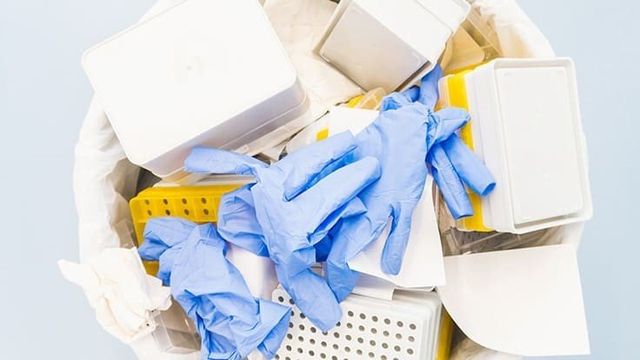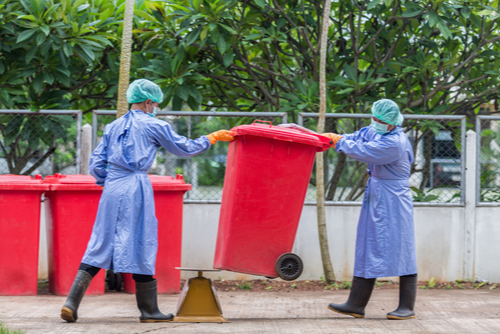Protecting Wellness: Revealing the Essence of Expert Medical Waste Removal
Wiki Article
Remain Ahead of Laws: Expert Suggestions on Medical Waste Disposal
In a globe where the health care industry is frequently progressing, it is crucial for medical facilities to remain ahead of policies when it comes to the appropriate disposal of medical waste. With rigorous standards and constant governing modifications, it can be testing to browse the complexities of this process. Nevertheless, with expert guidance, facilities can guarantee compliance and alleviate threats related to improper waste disposal. From recognizing the various classifications of clinical waste to implementing the appropriate collection and segregation techniques, this discussion will supply actionable pointers and important understandings to assist facilities stay in advance of guidelines in the ever-changing landscape of clinical garbage disposal.Understanding Medical Waste Categories
Recognizing medical waste classifications is necessary for correct disposal and administration in health care centers. Medical waste describes any type of waste generated by health care activities that may pose a hazard to public health and wellness or the atmosphere. It is important to categorize clinical waste precisely to ensure its secure handling, therapy, transportation, and disposal.There are a number of classifications of medical waste that medical care facilities require to be aware of. One of the most typical categories consist of infectious waste, pathological waste, sharps waste, pharmaceutical waste, and chemical waste. Each classification has specific guidelines and guidelines for its proper administration and disposal.
Infectious waste consists of products contaminated with blood or various other bodily liquids, such as handwear covers, gowns, and research laboratory societies. Pathological waste refers to human cells, body organs, or body components that call for unique handling and disposal. Sharps waste includes made use of needles, syringes, and various other sharp things that can cause injury and transfer infections. Pharmaceutical waste makes up run out, unused, or infected medicines that require careful handling and disposal. Lastly, chemical waste includes solvents, disinfectants, and other chemical substances utilized in medical care centers.
Staying Up-To-Date With Regulatory Modifications
Remaining current with governing adjustments is crucial for medical care centers to make certain compliance and proper management of medical waste disposal. medical waste removal service. With regulations regularly developing, it is vital for medical care facilities to remain current to avoid charges, penalties, and possible injury to the setting and public wellnessTo remain in advance of regulative adjustments, medical care centers should develop a system for monitoring and tracking updates. This can be done by registering for regulative newsletters, attending workshops and meetings, and proactively joining sector organizations. Furthermore, facilities must mark a personnel or group accountable for remaining notified and distributing information to pertinent stakeholders.
Regular interaction with regulatory agencies is additionally crucial. Medical care facilities should establish relationships with regional, state, and federal firms to ensure they understand any changes in guidelines that may affect their waste administration techniques. This can be done with regular conferences, involvement in public comment periods, and positive involvement with regulative agencies.
Moreover, health care facilities ought to think about partnering with waste monitoring business that specialize in medical garbage disposal (medical waste disposal services with WasteX). These business are often fluent in the most up to date guidelines and can give assistance and support to make certain conformity
Implementing Proper Collection and Segregation Techniques
To properly manage clinical garbage disposal, healthcare centers have to develop proper collection and segregation approaches according to regulative standards. Executing these techniques makes certain the risk-free handling and disposal of potentially unsafe products, secures the environment, and decreases the threat of infections and injuries to health care workers and the public.
Proper collection and segregation techniques include using marked containers and identifying systems. Healthcare facilities should supply clearly identified containers for various kinds of clinical waste, such as sharps, contagious waste, pharmaceutical waste, and non-hazardous waste. These containers should be color-coded and clearly significant to prevent confusion and advertise very easy identification.
Furthermore, healthcare facilities should educate their staff on the proper procedures for accumulating and segregating clinical waste. This consists of informing them on the different kinds of waste, the ideal containers to make use of, and the relevance of following laws and guidelines. Normal training sessions and refresher courses must be performed to make sure that employee continue to be up-to-date on finest methods.
Furthermore, health care centers must establish a system for routine collection and disposal of clinical waste. This may involve partnering with accredited waste administration business that focus on clinical garbage disposal. These business will guarantee that the gathered waste is transported and gotten rid of in compliance with regulative requirements.
Picking the Right Disposal Approaches

Incineration is one of the most common and efficient approaches for disposing of specific kinds his explanation of medical waste, such as pathological waste and sharps. It entails the regulated combustion of waste at high temperature levels, decreasing it to ash. Incineration can launch harmful contaminants right into the air and add to air contamination.

Various other disposal methods consist of chemical therapy, microwave therapy, and landfilling. Chemical medical waste disposal services with WasteX treatment involves the use of chemicals to neutralize the waste and decontaminate. Microwave treatment utilizes microwave energy to heat and disinfect the waste. Landfilling includes hiding the waste in a marked garbage dump location (medical waste disposal services with WasteX). Landfilling should be the last hotel due to the potential risk of contamination to dirt and groundwater.
Making Certain Conformity Through Paperwork and Training
After thoroughly thinking about the appropriate disposal approaches for clinical waste, healthcare facilities should make certain compliance with laws and decrease environmental effect by applying effective documentation and training treatments. This action is essential in keeping a safe and lasting environment for both healthcare employees and the basic public.
Training is just as important in guaranteeing compliance with regulations. Health care employees that manage medical waste must receive suitable training on waste partition, managing, and disposal procedures. This training should cover subjects such as the correct use of personal safety equipment, recognition of different types of waste, and the correct disposal methods for each waste classification. By providing thorough training, healthcare centers can empower their personnel to make educated decisions and reduce the threat of improper garbage disposal.
Conclusion
In verdict, staying in advance of regulations in medical waste disposal is critical for read medical care centers. medical waste removal services. Recognizing the different categories of medical waste, remaining upgraded with governing modifications, implementing correct collection and partition techniques, choosing the proper disposal methods, and ensuring compliance via paperwork and training are all important steps. By complying with these guidelines, health care companies can properly take care of and dispose of clinical waste in a liable and risk-free mannerFrom recognizing the different classifications of clinical waste to executing the appropriate collection and segregation methods, this discussion will certainly supply actionable pointers and important understandings to help facilities remain ahead of policies in the ever-changing landscape of medical waste disposal. - medical waste disposal services with WasteX
The most usual categories include transmittable waste, pathological waste, sharps waste, pharmaceutical waste, and chemical waste. Health care facilities need to offer plainly labeled containers for different types of medical waste, such as sharps, infectious waste, pharmaceutical waste, and non-hazardous waste. Health care centers should develop a detailed system to videotape and track all facets of medical waste disposal, consisting of kinds of waste produced, amounts, and disposal approaches made use of. Medical care employees who manage clinical waste must obtain ideal training on waste partition, handling, and disposal procedures.
Report this wiki page